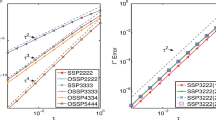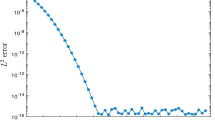Abstract
In this paper, we present a class of high-order, large time-stepping, and delay-free stabilization schemes for the Allen-Cahn equation. First, we apply a Fourier pseudo-spectral method for spatial discretization, and then, we establish the \(l^{2}\)-bound of the semi-discrete system. Furthermore, by adopting a time-step-dependent stabilization technique and taking advantage of recursive approximation of the exponential functions, we propose a class of stabilization Runge-Kutta schemes that preserve \(l^2\)-bound for any time-step size. Finally, we eliminate the delayed convergence brought by stabilization via a relaxation technique. Consequently, the resulting up-to-fourth-order parametric relaxation integrating factor Runge-Kutta (pRIFRK) schemes preserve the \(l^{2}\)-boundedness unconditionally with suitably chosen stabilization parameters. We also prove that the first-order pRIFRK scheme is unconditionally dissipative, w.r.t. a modified energy function, and the temporal convergence in the \(l^{2}\)-norm is estimated with pth-order accuracy. Numerical experiments are carried out to demonstrate the high-order accuracy, structure-preserving properties, and performance of the proposed schemes.












Similar content being viewed by others
Availability of data and material
All data generated or analyzed during this study are included in the manuscript.
Code availability
Custom code.
References
Allen, S.M., Cahn, J.W.: A microscopic theory for antiphase boundary motion and its application to antiphase domain coarsening. Acta Metall. 27(6), 1085–1095 (1979)
Douglas Jr, J., Dupont, T.: Alternating-direction Galerkin methods on rectangles. In: Numerical Solution of Partial Differential Equations–II, pp. 133–214. Elsevier (1971)
Du, Q., Ju, L., Li, X., Qiao, Z.: Maximum principle preserving exponential time differencing schemes for the nonlocal Allen-Cahn equation. SIAM J. Numer. Anal. 57(2), 875–898 (2019)
Du, Q., Ju, L., Li, X., Qiao, Z.: Maximum bound principles for a class of semilinear parabolic equations and exponential time-differencing schemes. SIAM Rev. 63(2), 317–359 (2021)
Elliott, C.M., Stuart, A.: The global dynamics of discrete semilinear parabolic equations. SIAM J. Numer. Anal. 30(6), 1622–1663 (1993)
Eyre, D.J.: An unconditionally stable one-step scheme for gradient systems. Unpublished Article 6 (1998)
Feng, X., Tang, T., Yang, J.: Stabilized Crank-Nicolson/Adams-Bashforth schemes for phase field models. East Asian J. Applied Math. 3(1), 59–80 (2013)
Feng, X., Tang, T., Yang, J.: Long time numerical simulations for phase-field problems using p-adaptive spectral deferred correction methods. SIAM J. Sci. Comput. 37(1), A271–A294 (2015)
Fu, Z., Yang, J.: Energy-decreasing exponential time differencing Runge-Kutta methods for phase-field models. J. Comput. Phys. 454, 110943 (2022)
Gottlieb, S., Ketcheson, D.I., Shu, C.W.: Strong stability preserving Runge-Kutta and multistep time discretizations. World Sci. (2011)
Hesthaven, J.S., Gottlieb, S., Gottlieb, D.: Spectral methods for time-dependent problems, vol. 21. Cambridge University Press (2007)
Huang, J., Shu, C.W.: Bound-preserving modified exponential Runge-Kutta discontinuous Galerkin methods for scalar hyperbolic equations with stiff source terms. J. Comput. Phys. 361, 111–135 (2018)
Isherwood, L., Grant, Z.J., Gottlieb, S.: Strong stability preserving integrating factor Runge-Kutta methods. SIAM J. Numer. Anal. 56(6), 3276–3307 (2018)
Jeong, D., Kim, J.: Conservative Allen-Cahn-Navier-Stokes system for incompressible two-phase fluid flows. Comput. Fluids 156, 239–246 (2017)
Jiang, K., Ju, L., Li, J., Li, X.: Unconditionally stable exponential time differencing schemes for the mass-conserving Allen-Cahn equation with nonlocal and local effects. Numer. Methods Partial Differ. Equ. 38(6), 1636–1657 (2022)
Ju, L., Li, X., Qiao, Z.: Generalized SAV-exponential integrator schemes for Allen-Cahn type gradient flows. SIAM J. Numer. Anal. 60(4), 1905–1931 (2022)
Ju, L., Li, X., Qiao, Z., Zhang, H.: Energy stability and error estimates of exponential time differencing schemes for the epitaxial growth model without slope selection. Math. Comput. 87(312), 1859–1885 (2018)
Kraaijevanger, J.F.B.M.: Contractivity of Runge-Kutta methods. BIT Numer. Math. 31(3), 482–528 (1991)
Lawson, J.D.: Generalized Runge-Kutta processes for stable systems with large Lipschitz constants. SIAM J. Numer. Anal. 4(3), 372–380 (1967)
Li, D., Quan, C., Xu, J.: Stability and convergence of Strang splitting. Part I: scalar Allen-Cahn equation. J. Comput. Phys. 458, 111087 (2022)
Li, J., Ju, L., Cai, Y., Feng, X.: Unconditionally maximum bound principle preserving linear schemes for the conservative Allen-Cahn equation with nonlocal constraint. J. Sci. Comput. 87, 1–32 (2021)
Li, J., Li, X., Ju, L., Feng, X.: Stabilized integrating factor Runge-Kutta method and unconditional preservation of maximum bound principle. SIAM J. Sci. Comput. 43(3), A1780–A1802 (2021)
Li, Y., Kim, J.: An unconditionally stable hybrid method for image segmentation. Appl. Numer. Math. 82, 32–43 (2014)
Liu, C., Shen, J.: A phase field model for the mixture of two incompressible fluids and its approximation by a Fourier-spectral method. Phys. D: Nonlinear Phenom. 179(3–4), 211–228 (2003)
Ruuth, S.J., Spiteri, R.J.: Two barriers on strong-stability-preserving time discretization methods. J. Sci. Comput. 17, 211–220 (2002)
Shen, J., Xu, J., Yang, J.: A new class of efficient and robust energy stable schemes for gradient flows. SIAM Rev. 61(3), 474–506 (2019)
Shen, J., Yang, X.: Numerical approximations of Allen-Cahn and Cahn-Hilliard equations. Discrete Contin. Dyn. Syst 28(4), 1669–1691 (2010)
Shu, C.W., Osher, S.: Efficient implementation of essentially non-oscillatory shock-capturing schemes, II. J. Comput. Phys. 83(1), 32–78 (1989)
Tang, T., Yang, J.: Implicit-explicit scheme for the Allen-Cahn equation preserves the maximum principle. J. Comput. Math. 451–461 (2016)
Xu, C., Tang, T.: Stability analysis of large time-stepping methods for epitaxial growth models. SIAM J. Numer. Anal. 44(4), 1759–1779 (2006)
Xu, J., Li, Y., Wu, S., Bousquet, A.: On the stability and accuracy of partially and fully implicit schemes for phase field modeling. Comput. Methods Appl. Mech. Eng. 345, 826–853 (2019)
Yang, J., Du, Q., Zhang, W.: Uniform \(l^{p}\)-bound of the Allen-Cahn equation and its numerical discretization. Int. J. Numer. Anal. Model. 15 (2018)
Zhang, H., Zhang, G., Liu, Z., Qian, X., Song S.: On the maximum principle and high-order, delay-free integrators for the viscous Cahn-Hilliard equation (2022)
Zhang, H., Qian, X., Xia, J., Song, S.: Efficient inequality-preserving integrators for differential equations satisfying forward Euler conditions. ESAIM: Math. Model. Numer. Anal. 57(3), 1619–1655 (2023)
Zhang, H., Yan, J., Qian, X., Chen, X., Song, S.: Explicit third-order unconditionally structure-preserving schemes for conservative Allen-Cahn equations. J. Sci. Comput. 90, 1–29 (2022)
Zhang, H., Yan, J., Qian, X., Song, S.: Numerical analysis and applications of explicit high order maximum principle preserving integrating factor Runge-Kutta schemes for Allen-Cahn equation. Appl. Numer. Math. 161, 372–390 (2021)
Zhang, H., Yan, J., Qian, X., Song, S.: Up to fourth-order unconditionally structure-preserving parametric single-step methods for semilinear parabolic equations. Comput. Methods Appl. Mech. Eng. 393, 114817 (2022)
Zhu, L., Ju, L., Zhao, W.: Fast high-order compact exponential time differencing Runge-Kutta methods for second-order semilinear parabolic equations. J. Sci. Comput. 67, 1043–1065 (2016)
Acknowledgements
The authors would like to thank the editor and the anonymous referee for their constructive comments and suggestions that greatly improved the quality of this research.
Funding
This work was supported by the National Natural Science Foundation of China (12271523, 12071481, 11971481), Defense Science Foundation of China (2021-JCJQ-JJ-0538), National Key R &D Program of China (SQ2020YFA0709803), Science & Technology Innovation Program of Hunan Province (2021RC3082, 2022RC1192), Natural Science Foundation of Hunan (2021JJ20053) and Research fund from College of Science, National University of Defense Technology (2023-lxy-fhjj-002).
Author information
Authors and Affiliations
Contributions
X. Teng: conceptualization, formal analysis, software, writing — review and editing; H. Zhang: writing — review and editing.
Corresponding author
Ethics declarations
Conflict of interest
The authors declare no competing interests.
Additional information
Publisher's Note
Springer Nature remains neutral with regard to jurisdictional claims in published maps and institutional affiliations.
Appendices
Appendix A. Some non-negative RK Butcher tableaux with non-decreasing abscissas and optimal SSP coefficients

RK\(^+\)(5, 4) [13], \(\mathcal {C} = 1.346586417284006\), \(c \approx [0, 0.4549, 0.5165, 0.5165, 0.9903]^T\):
Appendix B. Butcher tableaux of ETDRK schemes
Some first- and second-order ETDRK schemes that preserve \(l^{2}\)-boundedness are presented in the following Butcher-like tableaux.

Among them, the abscissas of ETDEKII and ETDRKIV schemes are required to meet \(c_{1} \ge 1\), the abscissa of ETDRKIII scheme is required to meet \(c_{1} \ge \frac{1}{2}\), and \(\varphi _{k, i}\left( \tau L_{\kappa }\right) =\varphi _{k}\left( c_{i} \tau L_{\kappa }\right) \).
Appendix C. Error estimates with global Lipschitz assumption
We modify the potential function F(u) such that its second derivative is bounded. For a large enough constant \(\beta > 1\), we modify F(u) by
Then we replace f(u) by,
Thus, we have \(\max _{u \in \mathbb {R}}|\tilde{f}^{\prime }(u)| \le 3 \beta ^{2}-1\).
Lemma C.1
Given any fixed \(t \in (0, T]\), when \(\kappa >0\), there exists \( l_{\kappa }=3 \beta ^{2}-1+\kappa \), such that for all \( \varvec{u}, \varvec{v} \in \mathbb {R}^{N},\Vert \varvec{u}\Vert _{l^{2}} \le 1,\Vert \varvec{v}\Vert _{l^{2}} \le 1\), we have
where \(l_{\kappa }\) is a constant independent of N.
Proof
It should be noted that \(\Vert f^{\prime }(\varvec{u})\Vert _{l^{\infty }} \le 3 \beta ^{2}-1 \). Applying Lagrange’s mean value theorem gives
where \(\varvec{\xi }=\theta \varvec{u}+(1-\theta ) \varvec{v}\), \(\theta \in (0,1)\), and \( l_{\kappa }=3 \beta ^{2}-1+\kappa \). \(\square \)
Theorem C.2
Assume \(\varvec{u}(t) \in C^{p+1}([0, T]; \mathbb {U}^{N})\) is the exact solution to the semi-discrete ODE system (3), \(\varvec{u}^{n}\) is a numerical solution computed by pRIFRK schemes with non-negative coefficients and non-decreasing parametric abscissas \(\hat{c}_{i}\) that meet pth-order conditions in Table 2, when \(\kappa \ge \max \{\frac{1}{\tilde{\tau }_{F E}}-\frac{\mathcal {C}}{\tau }, 0\}\), and \(\Vert \varvec{u}^{0}\Vert _{l^{2}} \le 1\), we have error estimates
where \(\hat{t}_{n}=n \hat{\tau }\).
Proof
The Butcher form of the pRIFRK schemes is
We may as well set \(U_{n, i}\), \(0 \le i \le s\) as reference solutions for the pRIFRK schemes, and \(U_{n,0}=\varvec{u}(\hat{t}_{n})\), \(U_{n,s}=\varvec{u}(\hat{t}_{n+1})\). Then we have
According to Theorem 3.2, for an s-stage pth-order pRIFRK scheme, the truncation error of pRIFRK solution satisfies
where \(C_{s}\) depends on the \(C^{p+1}[0, T]\)-norm of \(\varvec{u}\), \(\Vert L\Vert _{\infty }\), N, s, and \(\kappa \), but is independent of \(\tau \). Assume \(e^{n}=\varvec{u}(\hat{t}_{n})-\varvec{u}^{n}\), \(e_{n, i}=U_{n, i}-\varvec{u}_{n, i}\), \(1 \le i \le s\). Then \(e_{n, 0}=e^{n}, e_{n, s}=e^{n+1}\). Let \(\varDelta _{n, j}=N_{\kappa }( U_{n, j})-N_{\kappa }(\varvec{u}_{n, j})\), subtract (49) from (50) and (51), and we can obtain
According to Lemmas 2.3, C.1, using the triangle inequality, we can obtain
Then we have
i.e.,
Assume \(\Vert e^{0}\Vert =0\), \(n \tau =\frac{\hat{t}_{n}}{\hat{c}_{s}}\), \(C=\frac{C_{s}}{l_{\kappa } s}\). Then we can obtain \(\Vert e^{n}\Vert _{l^{2}} \le C(e^{l_{\kappa } s \frac{\hat{t}_{n}}{\hat{c}_{s}}}-1) \tau ^{p}.\) \(\square \)
Rights and permissions
Springer Nature or its licensor (e.g. a society or other partner) holds exclusive rights to this article under a publishing agreement with the author(s) or other rightsholder(s); author self-archiving of the accepted manuscript version of this article is solely governed by the terms of such publishing agreement and applicable law.
About this article
Cite this article
Teng, X., Zhang, H. High-order \(L^{2}\)-bound-preserving Fourier pseudo-spectral schemes for the Allen-Cahn equation. Numer Algor 97, 1859–1894 (2024). https://doi.org/10.1007/s11075-024-01772-5
Received:
Accepted:
Published:
Issue Date:
DOI: https://doi.org/10.1007/s11075-024-01772-5




